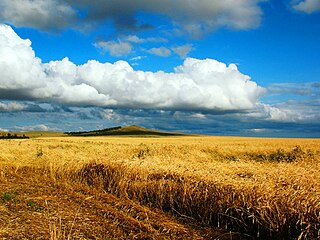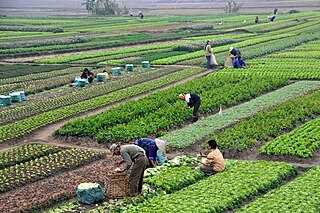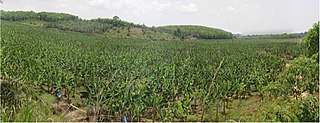
The economy of Benin remains underdeveloped and dependent on subsistence agriculture and cotton. Cotton accounts for 40% of Benin's GDP and roughly 80% of official export receipts. There is also production of textiles, palm products, and cocoa beans. Maize (corn), beans, rice, peanuts, cashews, pineapples, cassava, yams, and other various tubers are grown for local subsistence. Benin began producing a modest quantity of offshore oil in October 1982. Production ceased in recent years but exploration of new sites is ongoing.

The economy of Burkina Faso is based primarily on subsistence farming and livestock raising. Burkina Faso has an average income purchasing-power-parity per capita of $1,900 and nominal per capita of $790 in 2014. More than 80% of the population relies on subsistence agriculture, with only a small fraction directly involved in industry and services. Highly variable rainfall, poor soils, lack of adequate communications and other infrastructure, a low literacy rate, and a stagnant economy are all longstanding problems of this landlocked country. The export economy also remained subject to fluctuations in world prices.

The economy of Mali is based to a large extent upon agriculture, with a mostly rural population engaged in subsistence agriculture.

Agriculture is a major industry in the United States, which is a net exporter of food. As of the 2017 census of agriculture, there were 2.04 million farms, covering an area of 900 million acres (1,400,000 sq mi), an average of 441 acres per farm.

Agriculture in Greece is based on small, family-owned dispersed units, while the extent of cooperative organization stays at low comparative levels, against all efforts that have been taken in the last 30 years, mainly under European Union supervision. Greek agriculture employs 528,000 farmers, 12% of the total labor force. It only produces 3.6% of the national GDP. Many of the country's immigrants are employed in the agricultural sector of the economy, as well as construction and public works.

Agriculture in Belarus can be divided into two segments: livestock production and crop production. Crop production slightly outweighs livestock production in the country's product mix, accounting for around 55% of gross agricultural output since 1995. Agriculture accounted for 7.9% GDP in 2013, while over the same year that sector accounted for only 3% GDP in the EU.

Agriculture in Nigeria is a branch of the economy in Nigeria, providing employment for about 35% of the population as of 2020. As reported by the FAO, agriculture remains the foundation of the Nigerian economy, despite the presence of oil in the country. It is the main source of livelihood for most Nigerians. The Agricultural sector is made up of four sub-sectors: Crop Production, Livestock, Forestry and Fishing.

Agriculture is one of the bases of Argentina's economy.
Agriculture in Uzbekistan employs 28% of the country's labor force and contributes 24% of its GDP. Crop agriculture requires irrigation and occurs mainly in river valleys and oases. Cultivable land is 4.5 million hectares, or about 10% of Uzbekistan's total area, and it has to be shared between crops and cattle. Desert pastures cover fully 50% of the country, but they support only sheep.

Agriculture in Kazakhstan remains a small scale sector of Kazakhstan's economy. Agriculture's contribution to the GDP is under 10% - it was recorded as 6.7%, and as occupying only 20% of labor. At the same time, more than 70% of its land is occupied in crops and animal husbandry. Compared to North America, a relatively small percentage of land is used for crops, with the percentage being higher in the north of the country. 70% of the agricultural land is permanent pastureland.

The agriculture of Brazil is historically one of the principal bases of Brazil's economy. While its initial focus was on sugarcane, Brazil eventually became the world's largest exporter of coffee, soybeans, beef, and crop-based ethanol.

In 2004, agriculture and forestry accounted for 21.8 percent of Vietnam's gross domestic product (GDP), and between 1994 and 2004, the sector grew at an annual rate of 4.1 percent. Agriculture's share of economic output has declined in recent years, falling as a share of GDP from 42% in 1989 to 26% in 1999, as production in other sectors of the economy has risen. However, agricultural employment was much higher than agriculture's share of GDP; in 2005, approximately 60 percent of the employed labor force was engaged in agriculture, forestry, and fishing. Agricultural products accounted for 30 percent of exports in 2005. The relaxation of the state monopoly on rice exports transformed the country into the world's second or third largest rice exporter. Other cash crops are coffee, cotton, peanuts, rubber, sugarcane, and tea.

Romania has an agricultural capacity of approximately 14.7 million hectares, of which only 10 million are used as arable land. In November 2008, an evaluation revealed that 6.8 million hectares are not used. In 2018 Romania was the third biggest agricultural producer of the EU and produced the largest amount of maize.
Agriculture in Cameroon is an industry that has plenty of potential.

Agriculture was the foundation of the economy in Ivory Coast and its main source of growth. In 1987 the agricultural sector contributed 35 percent of the country's GDP and 66 percent of its export revenues, provided employment for about two-thirds of the national work force, and generated substantial revenues despite the drop in coffee and cocoa prices. From 1965 to 1980, agricultural GDP grew by an average 4.6 percent per year. Growth of agricultural GDP from coffee, cocoa, and timber production, which totaled nearly 50 percent of Ivory Coast's export revenues, averaged 7 percent a year from 1965 to 1980.

The economy of Ivory Coast is stable and currently growing, in the aftermath of political instability in recent decades. The Ivory Coast's economy is largely market-based and depends heavily on the agricultural sector. Almost 70% of the Ivorian people are engaged in some form of agricultural activity. GDP per capita grew 82% in the 1960s, reaching a peak growth of 360% in the 1970s. But this proved unsustainable and it shrank by 28% in the 1980s and a further 22% in the 1990s. This decline, coupled with high population growth, resulted in a steady fall in living standards. The Gross national product per capita, now rising again, was about US$727 in 1996. It was substantially higher two decades before.
Agriculture in Germany represents only a minor sector of the national economy as the number of employees has rapidly declined since the 19th century Industrialisation period and again, drastically during the 20th century. By 1989 agriculture amounted to only 1.6 percent of the West German GDP. Although the percentage of the agricultural sector of the East German GDP was twice as high, its total proportion of the reunited Germany's GDP amounted to only about two percent. Despite the sector's relatively small work force, that continues to decline in the 21st century and the mere 0.9 percent value share in the national GDP (2007), its use of more than half of the country's surface area, its impact on the environment and its fundamental connection to health issues, makes it politically very important. As one of the four largest producers in the European Union, large scale outdoor vegetable cultivation, such as potatoes and cereals accounts for the highest output.
Poland's agricultural sector is vital for European and Global market because it produces a variety of agricultural, horticultural and animal origin products. The surface area of agricultural land in Poland is 15.4 million ha, which constitutes nearly 50% of the total area of the country.

Agriculture in South Africa contributes around 5% of formal employment, relatively low compared to other parts of Africa and the number is still decreasing, as well as providing work for casual laborers and contributing around 2.6 percent of GDP for the nation. Due to the aridity of the land, only 13.5 percent can be used for crop production, and only 3 percent is considered high potential land.

Agriculture is the main part of Tanzania's economy. As of 2016, Tanzania had over 44 million hectares of arable land with only 33 percent of this amount in cultivation. Almost 70 percent of the poor population live in rural areas, and almost all of them are involved in the farming sector. Land is a vital asset in ensuring food security, and among the nine main food crops in Tanzania are maize, sorghum, millet, rice, wheat, beans, cassava, potatoes, and bananas. The agricultural industry makes a large contribution to the country's foreign exchange earnings, with more than US$1 billion in earnings from cash crop exports.

















